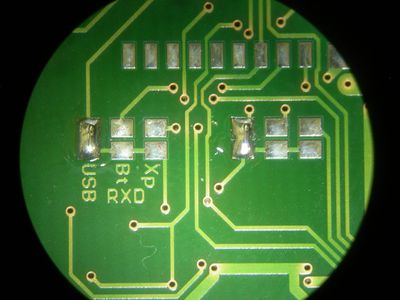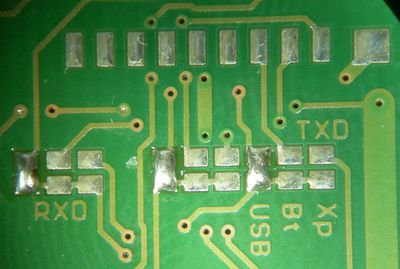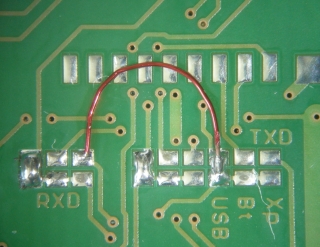Mode-S Beast:Solder Jumper Settings
Solder Jumper Settings
Solder jumpers are used to configure rarely changed functionalities as there are:
- the interface that you are using towards the PC, named RXD, TXD and RTS
- the solder jumpers SJ1, SJ2 and SJ3 located below the FPGA are currently not used
Solder jumpers are located on the bottom side of the PCB. The best soldering is done with 1mm solder. It is easier if the PCB is cold, so if you failed several times, let the board cool down.
Note 1: Often users did route RTS to USB and have RTS handshake enabled (IDP#8=ON) while using Xport. Since then the USB is unable to deliver its data, it deactivates RTS and disables the output of the decoder. For this use case, simply disable RTS (DIP#8=open) because the Xport does not provide an overload handling, better than that, I have the impression that the Xport does not get into overload at all.
Note 2: For the DIP function control over serial, RxD essentially must be routed to the interface that your application is using to connect the Mode-S Beast.
Solder Jumpers for Hardware Version 1.1
This hardware version requires just two solder jumpers, since the outgoing data is routed to all three devices at the same time. USB setting is normally done before shipping.
Routing and use of RTS is strongly recommended for the USB interface. With Xport, the RTS can either be disabled completly or the signal has to be re-routed to Xp position as well. Unfortunately the Xport does not have an overload handling of the RTS equal to the USB device, so it is no matter how you do.
Solder Jumpers for Hardware Version 1.0
RxData on the left, RTS in the center and TxData on the right. The picture shows the full routing of signals for USB, as it is normally done before shipping.
NOTE (1): TX-Data can be routed to all output devices in parallel, so for HW Version 1.1 this jumper block will be removed anyway. But mind NOTE (2)! NOTE (2): If you intend to use Lantronix Xport, the outgoing RxD and TxD are swapped in HW-Version 1.0! That means that the outgoing TxD signal nees to be routed with a wire to the pad in the RxD multiplexer, like shown on this picture:
Wiring of the Mode-S Beast for output using Serial-over-USB and Lantronix Xport at the same time.


